Selected works may include depictions of: the “human-animal bond,” animals grieving for humans and/or other animals, humans grieving for a beloved animal, connections to Nature, and/or burials. This gallery was curated by Eric Greene.
Note: All artwork may not depict literal themes of death or bereavement, but have been selected for their poignancy, symbolism or mood. Paintings and drawings are presented chronologically.
Death of the Historical Buddha, c. 1200.
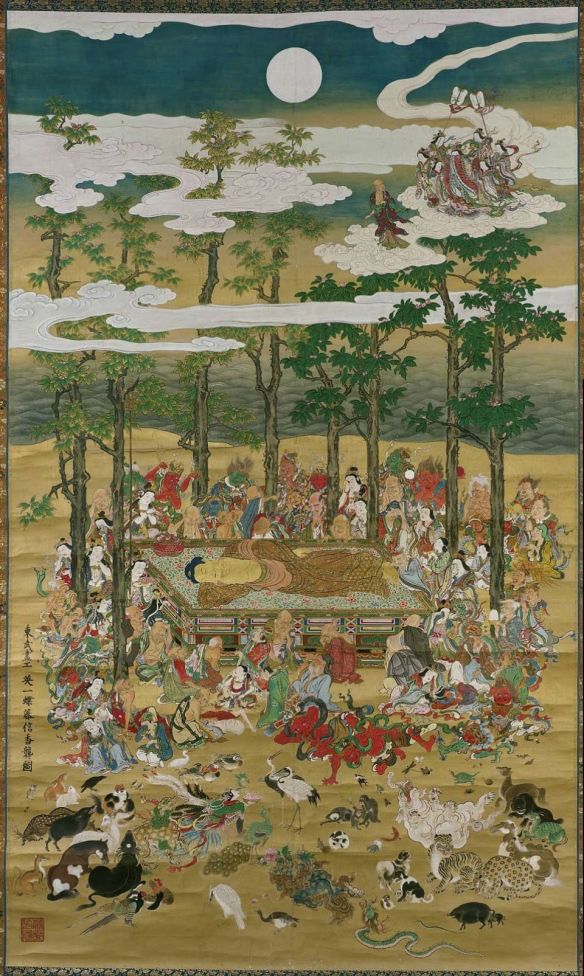
Death of the Historical Bddha. For more information, read here.
Gerrit Dou, Sleeping Dog Beside a Terracotta Jug. 1650.
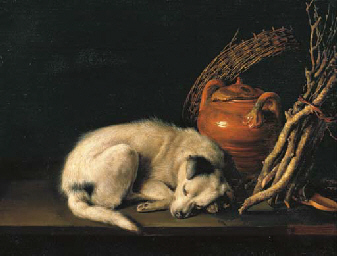
Francisco de Goya y Lucientes, Half-submerged Dog. c. 1823.
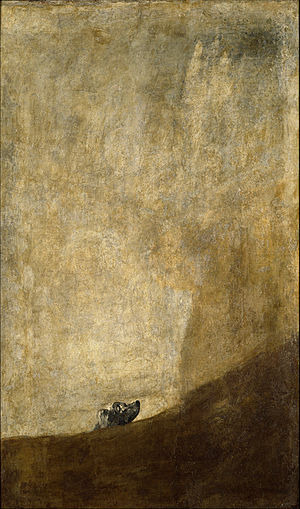
According to Museo Nacional del Prado, “The mural paintings that decorated the house known as “la Quinta del Sordo,” where Goya lived have come to be known as the Black Paintings…This piece has been related with the idea of the inevitability of death and is, beyond doubt, the most enigmatic of the Black Paintings…The German Expressionists and the Surrealist movement, as well as representative of other contemporary artistic movements, including literature and even cinema, have seen the origins of modern art in this series of compositions by an aged Goya, isolated in his own world and creating with absolute liberty.” It was also referenced by Laurie Anderson in her personal film, Heart of a Dog.
Edwin Henry Landseer, Attachment. 1829.
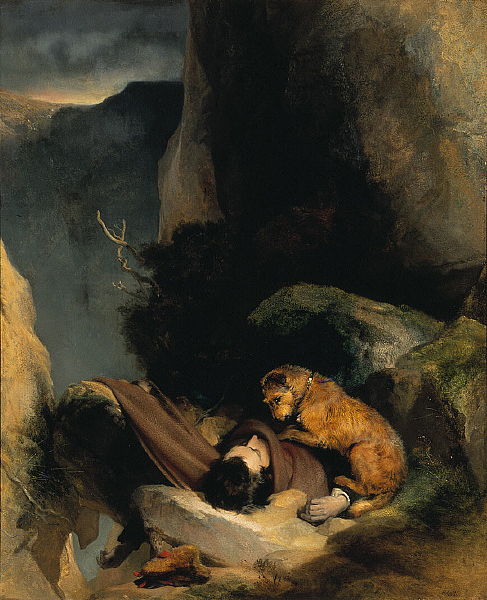
Edwin Henry Landseer, The Poor Dog (The Shephard’s Grave). 1829.
Edwin Henry Landseer, The Old Sheperd’s Chief Mourner. 1837.
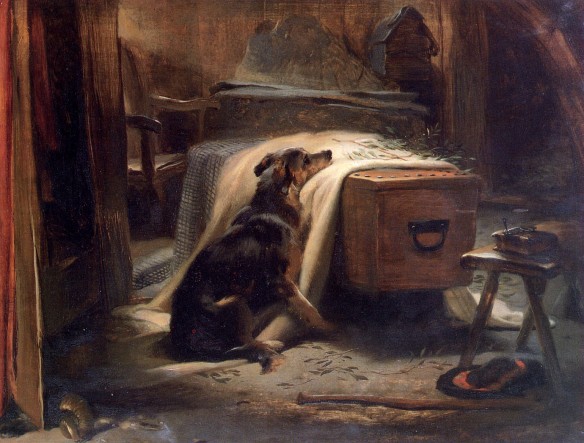
Historian Keri Cronin writes: “this painting became an important part of animal advocacy campaigns in the 19th century…in March 1881, it was reproduced on the pages of Our Dumb Animals, the publication of the Massachusetts Society for the Prevention of Cruelty to Animals (MSPCA), and declared to be “eminently appropriate” for this publication.” Read more at Our Hen House.
William Holman Hunt, The Scapegoat. 1856.
The Scapegoat was one of the best known and somewhat controversial religious paintings of the 19th century. It references an observance among ancient Hebrews described in Leviticus (read more here). Inscribed on the painting’s frame at top and bottom are two Biblical phrases:
Surely he hath borne our Griefs and carried our Sorrows, yet did we esteem him, stricken, smitten of GOD and afflicted. – Isaiah 53:4
And the Goat shall bear upon him all their Iniquities unto a Land not inhabited. – Leviticus 16:22
James Archer, A Dog Mourning Its Little Master. 1866.

Charles Christian Nahl, The Dead Miner. 1867.

From the Autry Museum’s Website: “Charles Christian Nahl established a career based on his paintings of California’s mining industry. Miners were portrayed in fiction and popular culture as either moral men or dissolute louts, offering lessons on virtue and vice. By the time Nahl painted this picture, the gold rush had long subsided. His work coincided with a popular reimagining of this legendary era as a time that tested the wills of men. His painting The Dead Miner was designed to elicit maximum sympathy: depicted as a martyr to progress, the miner’s outstretched hand clasps a portrait of his sweetheart, and he has only his loyal hound to mourn him.”
Briton Riviere, The Long Sleep, 1868.
Chierici Gaetano, Gioia e Dolore, 1871.


Gaetano specialized in anecdotal genre painting. Here, the contrast between joy and pain: the joy the boy feels, holding a beloved bird while in the company of his beloved cats, against the boy’s pain after the cats act as cats. The pain complicated by guilt for putting the bird at risk in the presence of the cats, and possible anger at the cat who killed the bird. One may also reflect upon the unnaturalness and cruelty of keeping birds in cages when they have wings to fly.
Gustave Doré, Les Saltimbanques [Magicians], 1874.

A painting known by many names, including The Acrobats, and The Wounded Child. Not a typical Doré, who was reportedly an accomplished acrobat himself. Of this painting, showing a child severely injured from a fall held close to his mother’s chest, he reportedly said “…[the child] is dying. I wished to depict the tardy awakening of nature in those two hardened almost brutalized beings. To gain money they have killed their child and in killing him they have found out that they had hearts.” This reality also affects two dogs, with whom we can imagine the child petting and playing. One in the foreground echoes the mother’s sentiment; she looks towards the child, lifting her paw towards to be close. The other dog echoes the father, looking forward, forlorn and helpless. The painting was elected as a favorite by museum visitors.
Briton Riviere, Sympathy. 1877.

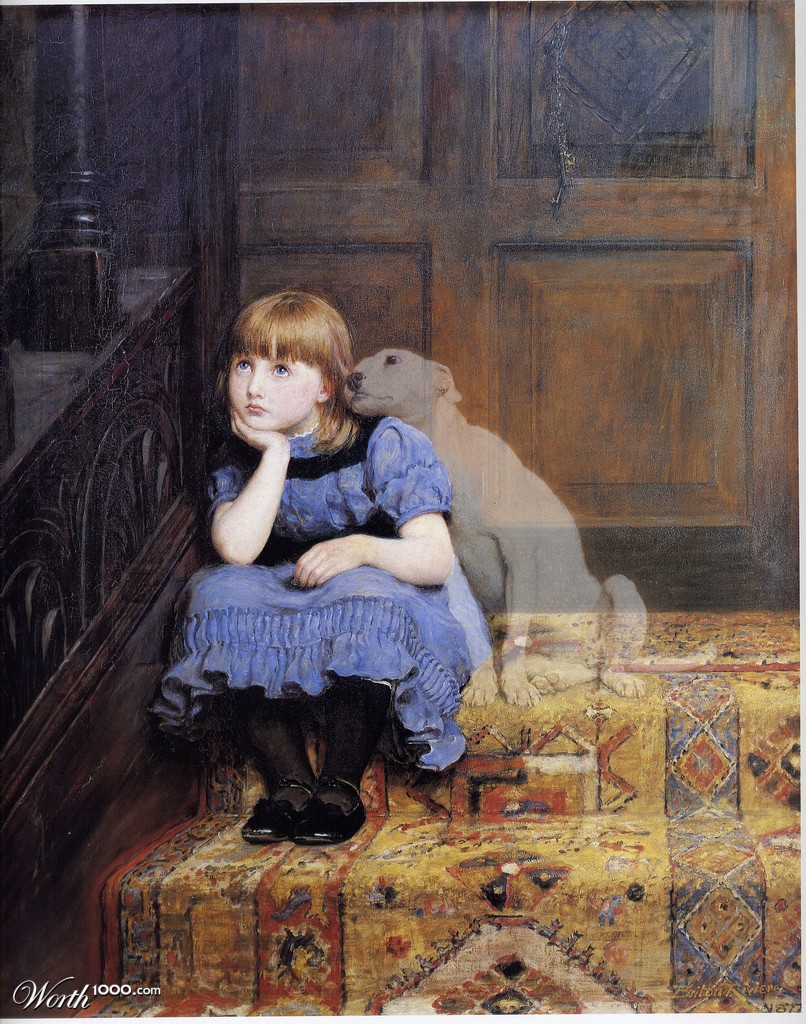
Riviere’s Sympathy was among the most well-known animal portraits of the day, as discussed by the Royal Holloway Collection: The Spectator made an important point: Riviere was the natural successor to Landseer, who had died in 1873, and that he had even surpassed Landseer in his own way, ‘for he has given feeling to his animals, and yet kept them strictly within their own nature . . . Never attempting to render in his works human expression in a dog’s face, he has nevertheless mastered the points where canine and human nature touch, and painted them with an insight and comprehension with which no other artist of whom we know can at all compare’. Read more
The painting has had a resurgence since 2007 when an artist rendered the dog as a ghost.
Anna Merritt, Portrait de Minna Sophia Farrer tenant un lapin. 1878.
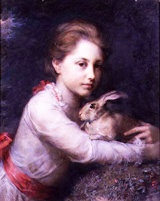
Marianne Stokes, A Parting. 1884.

Gourlay Steell. LLywelyn (1173-1240) and his Brave Hound, Gelert. 1880.
Charles Burton Barber, Gelert. c.1894.

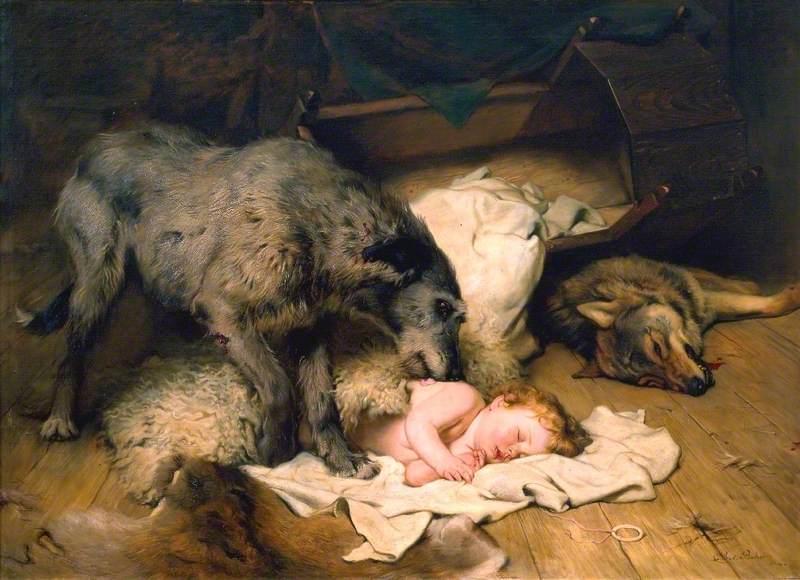
A popular Welsh legend tells of Llyweln returns to his home to find his dog, Gelert, with blood on his mouth, and his baby son’s blood-stained cradle. Not seeing his baby, Llyweln assumed Gelert killed his son and stabbed him with his sword. As Gelert gives his last yelp, Llyweln hears his son crying and sees a dead wolf by the baby’s crib; he realizes that Gelert killed the wolf to protect the baby. In his grief, Llyweln is noted to never to have smiled again. It turns out that other cultures have similar tales, and historians believe this legend to be a work of fiction (read more here).
August Friedrich Schenk, Anguish, c.1880, and L’Orphelin, c. 1885.
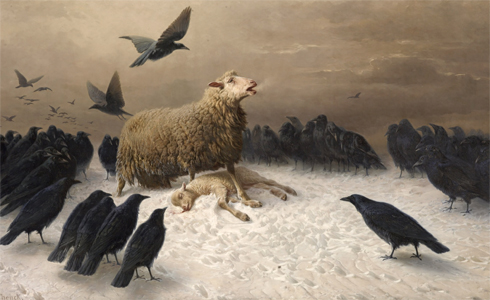
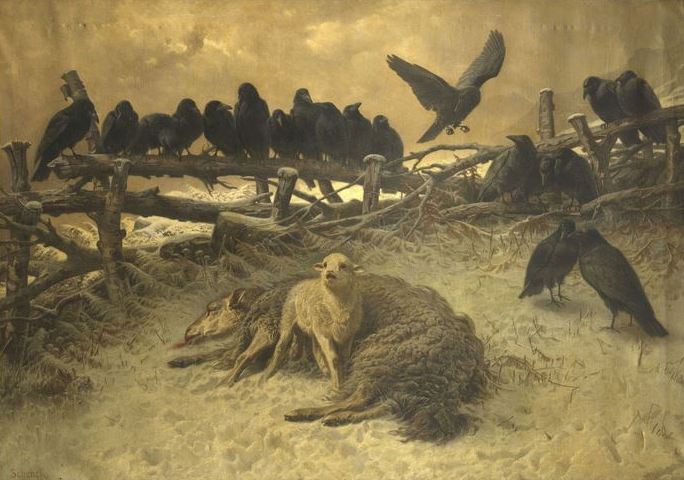
These two studies of grief are shown here together. The first, Anguish, is a mother sheep grieving for her lamb, and keeping the hungry crows at bay. The second, The Orphan, depicts a lamb grieving for its mother, amidst a patient murder of crows. Whereas we can imagine the mother in the first painting surviving this ordeal, the lamb in the second stands near a fence, presumably to be found by sympathetic persons.
Briton Rivière, Requiescat. 1888.
Max Kurzweil, A dear visitor (Ein Lieber Besuch), 1894. Austria.

Currier & Ives, The Burial of the Bird. c.1910.

Arthur Heyer, White Cat and Two Brimstone Butterflies. 1872-1931.
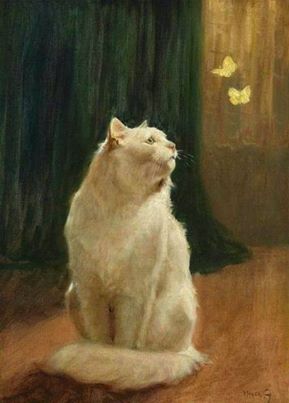
Vincent van Gogh, Tree Roots. 1890.

Fortunino Matania, Goodbye, Old Man. 1916.
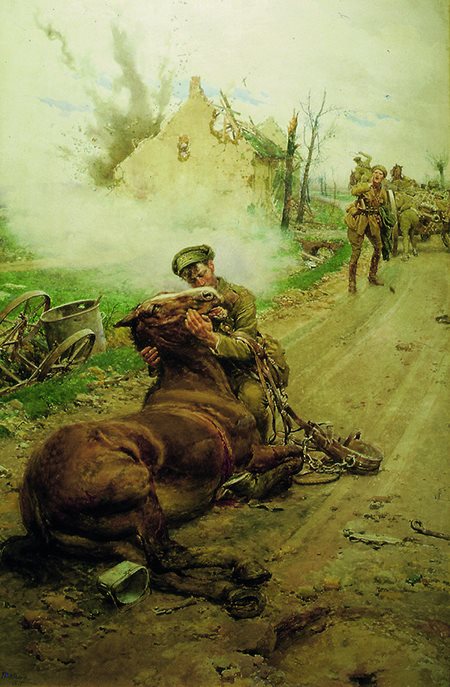
Italian artist, Chevalier Fortunino Matania, was commissioned in 1916 to raise money for The Blue Cross Fund, a London-based animal welfare charity. The painting, Goodbye, Old Man, shows a soldier bidding farewell to his fatally injured horse and is perhaps his most well known work. It now hangs in the boardroom of the charity’s animal hospital in Victoria, London. More than one million horses served with the British Army during World War I and the Blue Cross treated thousands. For more information, read Goodbye, Old Man: Matania’s Vision of the First World War, and Flynn’s, Soldiers and Their Horses.
Post-WWII artwork on page 2
revised April 3, 2025

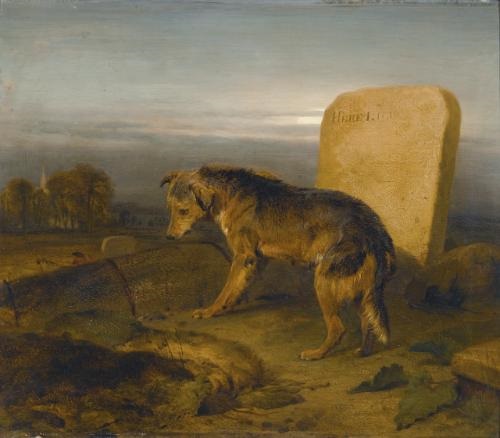



My son sent me the picture of “Ghost Dog” upon the death of my poodle. It is so moving and consoling and I thank you for putting it on your website for others who are grieving the loss of this best friend.
LikeLiked by 1 person
We’re glad this picture has provided comfort to many. We’re glad you found it on our website, along with the original painting by Riviere, and the other paintings, photographs, and short films chosen to comfort those who grieve.
LikeLiked by 1 person
Beautiful picture of the Ghost Dog – do you know where I can purchase a copy please.
LikeLike
Many people have found solace from that rendering of the Briton Riviere masterpiece. We tried to contact the artist, but have not received a reply. The link below the image takes you to artist’s original posting of Ghost Dog. You might try contacting the artist directly.
LikeLike
If your still looking for this picture I have one for sale
LikeLike
Note: The Green Pet-Burial Society cannot verify the authenticity of any comment. People are advised to use caution when entering into any transaction with other posters.
Sarah NIcholls – an introduction would be helfpul. Thank you.
LikeLike
All so wonderful and touched my emotions, but Ghost stole my heart! Thank you so much for sharing your wonderful paintings as I enjoyed each and every one of them!
LikeLiked by 1 person
We’re so glad you enjoyed this artwork and thank you for your feedback. We’ll be adding others in the future, so please come back, and visit other sections of our website as well.
LikeLike